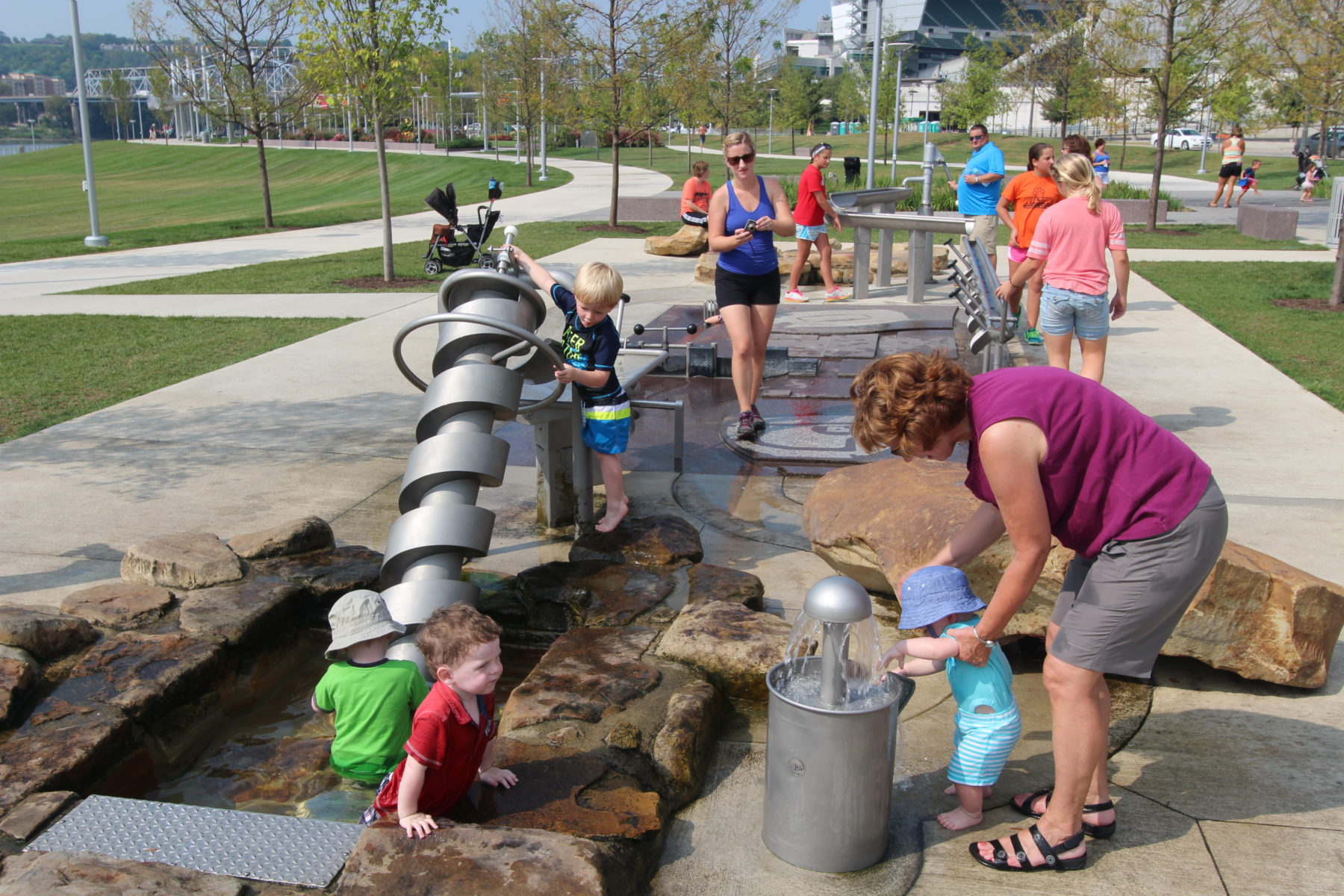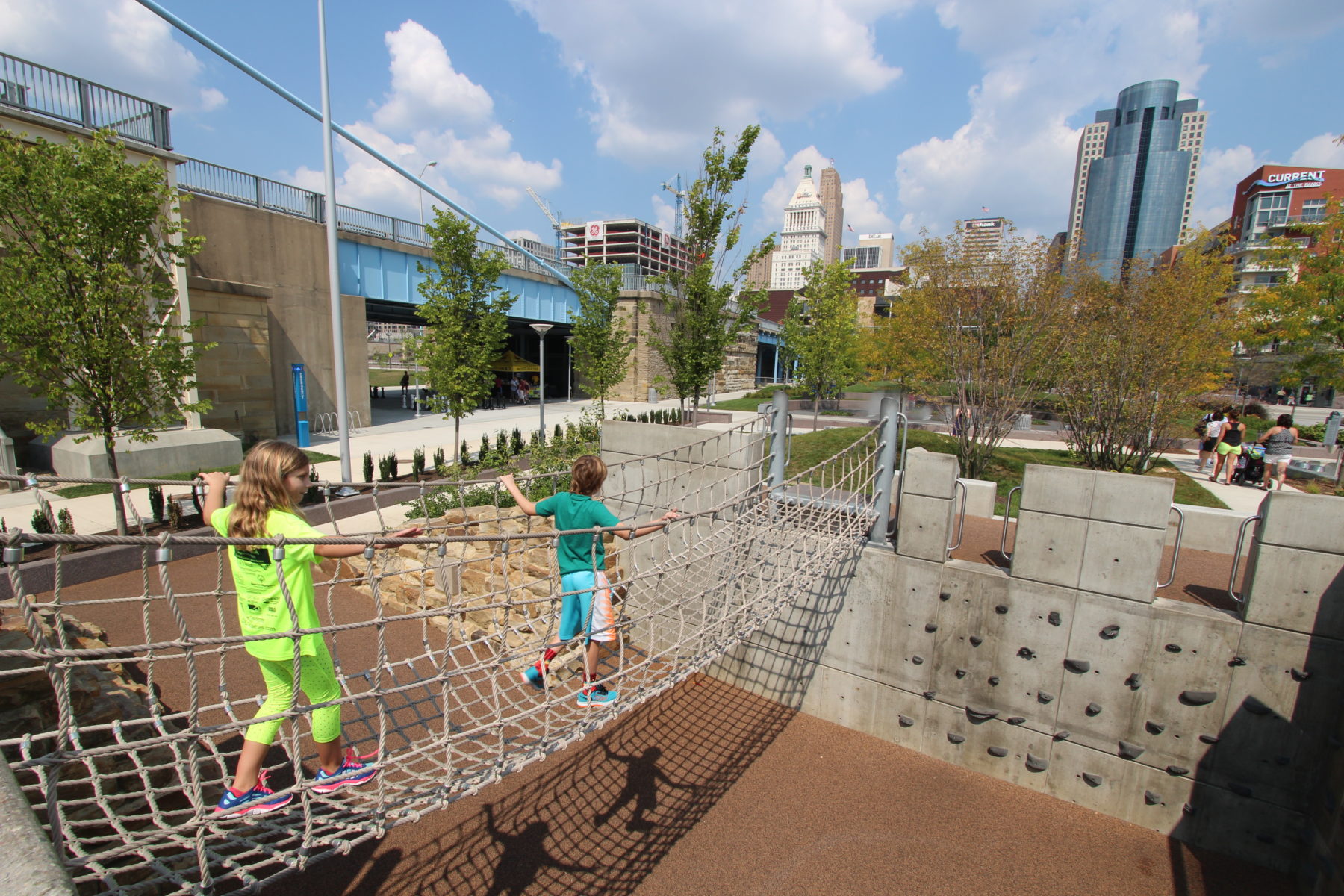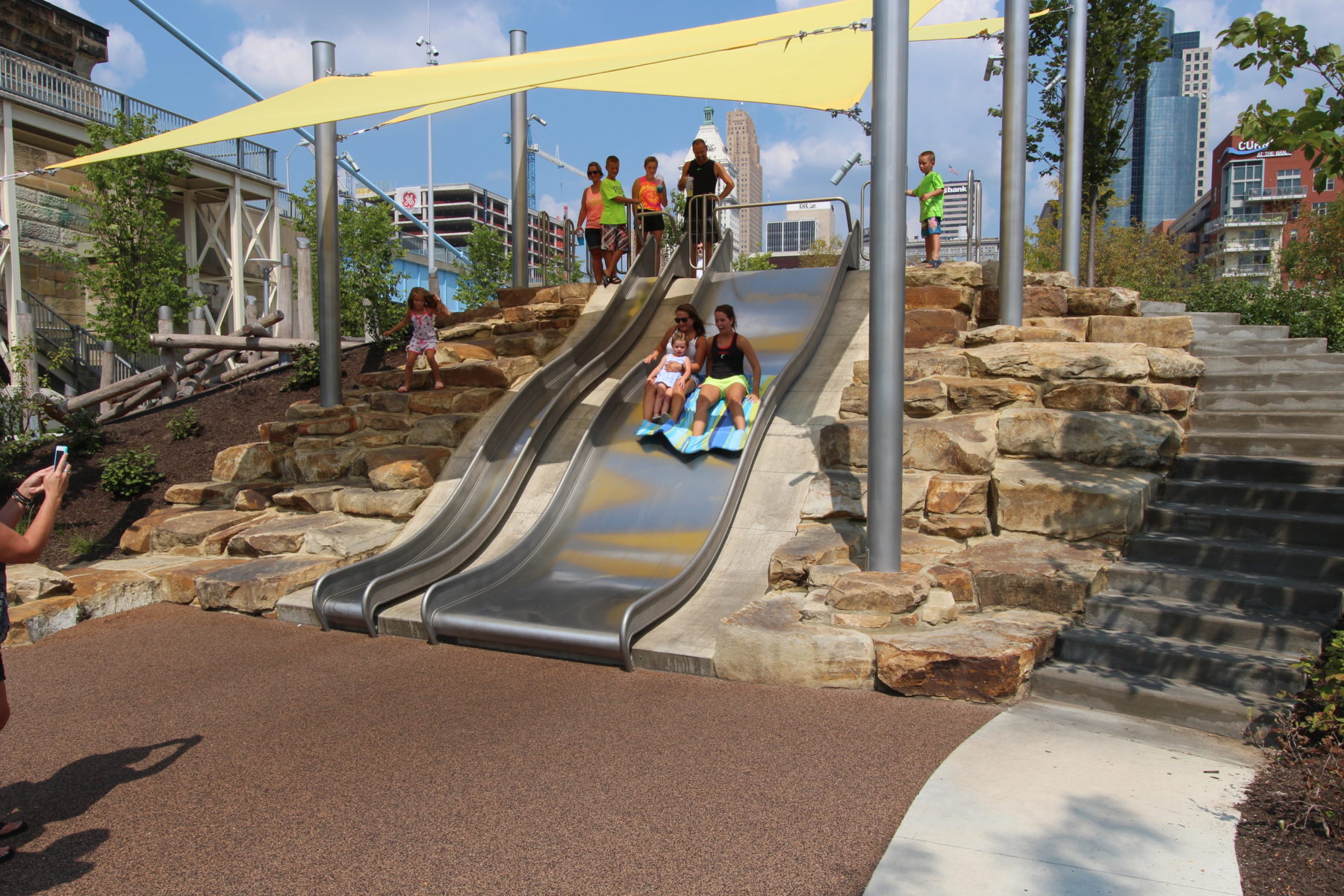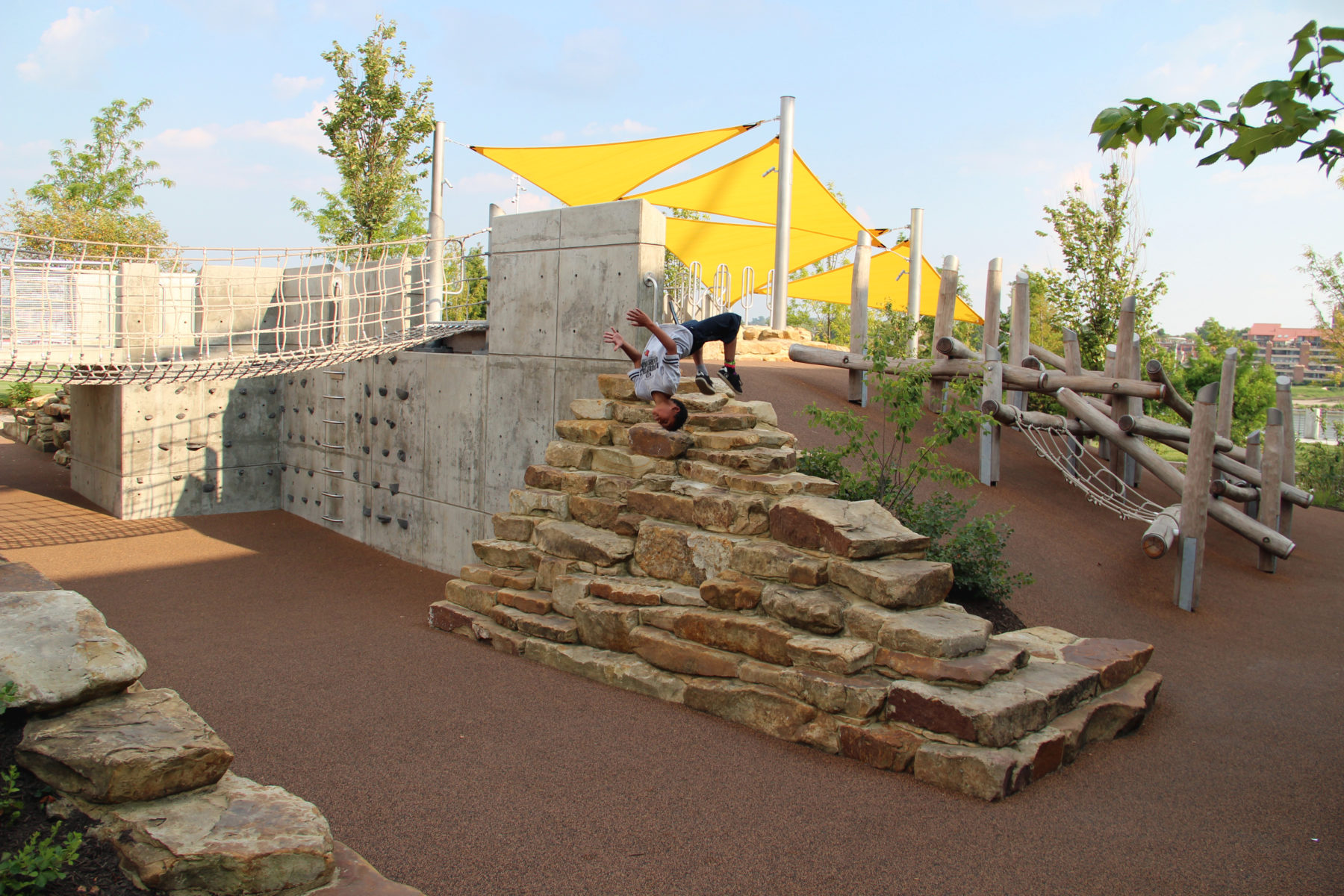Where Work Meets Play

 Sasaki
Sasaki

Screams of delight come from the slide hillside, mixing with the comfortable chatter of nearby parents. I watch a little girl launch herself down the slide. She hollers cheerfully as she careens off the end, taking a tumble before regaining her feet. She turns and flashes me a big smile, eyes shining, calling out, “Mama, come play!” I scribble down a few last notes and run over to join her.
The following was originally published in the July issue of National Recreation and Parks Association’s (NRPA) magazine, Parks and Recreation.
On this sunny Saturday in mid-October, myself, my daughter, Tessa, and a team of designers from Sasaki Associates Inc. are in Cincinnati to conduct a post-occupancy evaluation of the new playscapes at Smale Riverfront Park. The park sits on the banks of the Ohio River between Paul Brown Stadium and the Great American Ball Park. Cincinnati is hardly short on playgrounds—the Trust for Public Land ranks it No. 2 in the nation when it comes to playgrounds per capita—but in the six months since this playscape opened, it has become a regional destination for families. A park maintenance staffer said some parts of the park had “at least one child per square foot” on summer weekends.
It's a place that seems a bit wild and a little risky, a place where the unexpected can happen.
In part, the park is so popular because it is so different. Here, instead of the plastic post-and-platform structures of a typical American playground, climbing walls, boulders, bridges, logs and slide hillsides await curious kids. It’s a place that seems a bit wild and a little risky, a place where the unexpected can happen.
The refreshing change of pace at Smale is part of a nationwide movement to re-invigorate outdoor playspaces. Susan Solomon, author of American Playgrounds: Revitalizing Community Space, describes today’s default playground as “the McDonald’s model”: a garishly colored and unimaginative collection of posts, platforms, tunnels and slides stamped uniformly across the country. “Things like taking risks, learning to fail, learning to master something, to plan ahead, to develop deep friendships,” Solomon says, “none of those could take place on most playgrounds today.” Children are suffering as a result. A lack of free play opportunities is culpable in forming the habits of a generation of children who are less imaginative, creative, and expressive, according to Kyung-Hee Kim, an educational psychologist at the College of William and Mary and the author of the 2011 paper The Creativity Crisis.
A lack of free play opportunities is culpable in forming the habits of a generation of children who are less imaginative, creative, and expressive.
During the past decade a groundswell of play advocates—including parents, teachers and designers—have begun arguing that a reasonable level of risk in play is essential to children’s healthy development. The pendulum is slowly swinging back, with cities increasingly engaging designers in the creation of custom play environments that are contextual, place-specific and creative in their interpretation of the safety guidelines.
The making of Smale Park is a decades-long story of transformation. In the mid-1990s, most of the 32-acre site was a brownfield covered in parking and vacant industrial parcels that were regularly flooded by the adjacent Ohio River. A bold master-planning process in the late 1990s laid the groundwork for the park. In 1999, Sasaki was selected to develop concept plans and a team of landscape architects, urban planners and engineers conceived a multiphase approach, which began with making room for the park.
The park’s dedicated playscapes — the Heekin Family/Grow Up Great Adventure Playscape and the P&G goVibrant-scape—opened together in the late spring of 2015. They blur the traditional boundaries between park and playground—there are no fences separating zones. Instead, children and families encounter spaces from all directions and play spills out onto lawns and paths. The park was conceived as a family destination, integrating attractions like Carol Ann’s Carousel, fountains and a labyrinth, along with places to picnic, rent bikes, swing or sit by the river.
The design team and park board together aspired to set a new standard. “We wanted a place of adventure and challenge, not a typical playground composed of off-the-shelf components,” says Steven Schuckman, superintendent of planning and design for Cincinnati Parks. The goal was to create a playground “as unique and grounded in the site and its history as is the rest of the park.”
At the same time, three important private funding sources stepped forward: The Heekin Family, PNC Bank and Proctor & Gamble. The Heekin Family, along with PNC Bank, donated generously toward a playground that would inspire and challenge Cincinnati children to be physically active. Proctor & Gamble’s charitable foundation offered a grant to create a playful, interactive space that would engage families in explorations of cause and effect, promoting fun physical exercise. The aligned support of the park board and funders formed a strong foundation for conceptual design.
A research-based process greatly informed the layout and specific features of the PNC/Heekin Adventure Playscape. The design responds to six categories of risky play, as defined in a 2011 article in the journal Evolutionary Psychology by Ellen Sandseter, a professor at Queen Maud University in Trondheim, Norway. They include great heights, rapid speeds, dangerous tools, dangerous elements, rough and tumble, and disappearing/getting lost.

Elements like the slide, climbing walls and bridges were designed to help kids achieve feelings of great heights and rapid speeds, while small nooks in the rock outcrops and winding paths capture a sense of mystery. All custom design features meet the safety standards of the Public Playground Safety Handbook, a guide published by the Consumer Product Safety Commission.
The design team also sought to incorporate different types of play. Sara Smilanski, a renowned Israeli child psychologist who trained with Jean Piaget, developed a widely accepted theory in the late 1960s about four types of play that contribute to children’s learning and development. They are functional play—physical and gross-motor activities; constructive play—building and creating; dramatic play—engaging imagination; and role playing and games with rules.
As excitement about Smale Park grew, designers at Sasaki became interested in understanding and learning from the project. They wanted to unpack how children and families use the playscapes and how the park was performing from a maintenance and safety perspective.

Methodology: Sasaki’s research/design team—three landscape architects and one intrepid four-year old research assistant—traveled to Cincinnati to collect the data. We logged more than 45 observation hours and conducted more than 100 interviews.
Our chief methods included counting, tracking, listening and interviewing. Every 30 minutes, we conducted a full count of the people in the playscapes, capturing where children, adults, teens, strollers and dogs were distributed. Tracking consisted of mapping one child’s journey for 5 minutes. We tracked two to three times every 30 minutes. We conducted interviews with both visitors and stakeholders, including key park maintenance staff and leadership. And key to our qualitative data was intensive listening — we sat in each play zone for 10 minutes at a time, cataloging conversations.
Findings: We collected a substantial amount of qualitative and quantitative data, which revealed a number of key trends:

These takeaways gloss over a million nuances of the post-occupancy data, but together highlight how the park has developed a life of its own. As designers, funders, clients and stakeholders, we all dream big about what a park can be, but in the end, it is the community that really defines what it is. How they use the playscape, what they love and what they neglect—these are critical drivers of the park’s future and key learning moments for future designs.